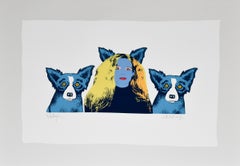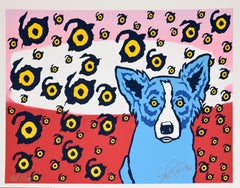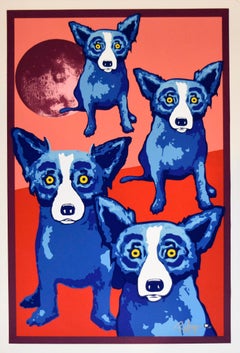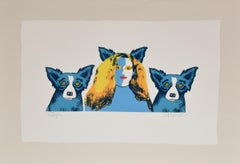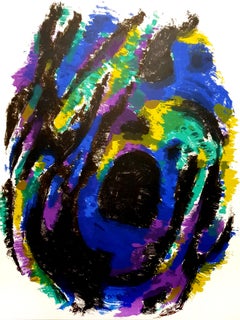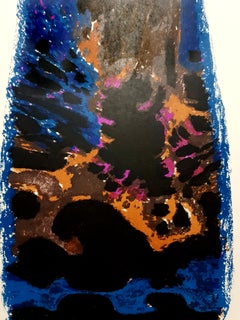Modern Art Animal Prints
to
51
124
117
163
78
16
Overall Width
to
Overall Height
to
125
92
68
51
19
18
18
11
4
4
2
1
32
20
14
13
12
4
5
377
112
1
1
4
11
18
60
98
64
51
3
267
212
19
2,724
1,767
1,463
1,084
853
543
498
451
444
409
358
356
323
249
239
188
174
151
144
140
222
119
74
71
25
74
152
293
165
Art Subject: Modern Art
Soul Mates - Variant 3 - Signed Silkscreen Print Blue Dog
Located in Mount Laurel, NJ
This Blue Dog work consists of a white background with a blue female with dog ears, red lips, yellow, orange and black hair, wearing a black shirt/sweater, centered between 2 blue do...
Category
1990s Pop Art Animal Prints
Materials
Screen
I See You, You See Me - Split Font Unique - Signed Silkscreen Print - Blue Dog
Located in Mount Laurel, NJ
This Blue Dog work consists of a single dog with soulful yellow eyes sitting on the right side of a pink, white and red background covered in the dog's soulful yellow eyes scattered ...
Category
1990s Pop Art Animal Prints
Materials
Screen
Vagabond Moon - Signed Silkscreen Print
Located in Mount Laurel, NJ
This Blue Dog work consists of a pink and red split background with the moon in the top left corner. There are 4 scattered dogs all with soulful yellow eyes. This pop art animal original silkscreen print...
Category
1990s Pop Art Animal Prints
Materials
Screen
Soul Mates - Variant I - Signed Silkscreen Print - Blue Dog
Located in Mount Laurel, NJ
This Blue Dog work consists of a white background with a blue and white female with yellow and black hair centered between 2 blue dogs. All 3 have soulful yellow eyes. This pop art...
Category
1990s Pop Art Animal Prints
Materials
Screen
Alfred Manessier - Original Lithograph
Located in Collonge Bellerive, Geneve, CH
Alfred Manessier - Original Lithograph
Colorful Abstraction
1962
From XXe Siecle
Dimensions: 32 x 24
Edition: G. di San Lazzaro.
Unsigned and unumbered as issued
Category
1960s Modern Figurative Prints
Materials
Lithograph
Alfred Manessier - Lithograph
Located in Collonge Bellerive, Geneve, CH
Alfred Manessier - Lithograph
1962
From the art periodical XXe Siecle (no. 20)
Dimensions: 32 x 24
Edition: G. di San Lazzaro.
Unsigned and unnumbered as issued
Category
1960s Modern Figurative Prints
Materials
Lithograph
(after) Max Ernst - Blue Bird - Stencil
Located in Collonge Bellerive, Geneve, CH
Max Ernst (after) - Blue Bird - Stencil
Published in the deluxe art review, XXe Siecle, 1958
Dimensions: 32 x 25 cm
Publisher: G. di San Lazzaro.
Max Ernst was born in Bruhl, a place near Cologne, in Germany. He was raised in a strict Catholic family, and both of his parents were disciplinarians who were dedicated to training their children into God-fearing and talented individuals. Although his father was deaf, Ernst learned so much from him, particularly when it comes to painting. In fact, much of his early years were lived under the inspiration of his father who was also a teacher. He was the one who introduced painting to Ernst at an early age.
In 1914, Ernst attended the University of Bonn where he studied philosophy. However, he eventually dropped out of school because he was more interested in the arts. He claimed that his primary sources of interest included anything that had something to do with painting. Moreover, he became fascinated with psychology, among other subjects in school.
Primarily, Ernst's love for painting was the main reason why he became deeply interested with this craft and decided to pursue it later on in his life. During his early years, he became familiar with the works of some of the greatest artists of all time including Claude Monet, Paul Cezanne and Vincent van Gogh. He was also drawn to themes such as fantasy and dream imagery, which were among the common subjects of the works of Giorgio de Chirico.
During World War I, Ernst was forced to join the German Army, and he became a part of the artillery division that exposed him greatly to the drama of warfare. A soldier in the War, Ernst emerged deeply traumatized and highly critical of western culture. These charged sentiments directly fed into his vision of the modern world as irrational, an idea that became the basis of his artwork. Ernst's artistic vision, along with his humor and verve come through strongly in his Dada and Surrealists works; Ernst was a pioneer of both movements.
It was Ernst's memories of the war and his childhood that helps him create absurd, yet interesting scenes in his artworks. Soon, he took his passion for the arts seriously when he returned to Germany after the war. With Jean Arp, a poet and artist, Ernst formed a group for artists in Cologne. He also developed a close relationship with fellow artists in Paris who propagated Avant-Garde artworks.
In 1919, Ernst started creating some of his first collages, where he made use of various materials including illustrated catalogs and some manuals that produced a somewhat futuristic image. His unique masterpieces allowed Ernst to create his very own world of dreams and fantasy, which eventually helped heal his personal issues and trauma. In addition to painting and creating collages, Ernst also edited some journals. He also made a few sculptures that were rather queer in appearance.
In 1920s, influenced by the writings of psychologist Sigmund Freud, the literary, intellectual, and artistic movement called Surrealism sought a revolution against the constraints of the rational mind; and by extension, they saw the rules of a society as oppressive. Surrealism also embraces a Marxist ideology that demands an orthodox approach to history as a product of the material interaction of collective interests, and many renown Surrealism artists later on became 20th century Counterculture symbols such as Marxist Che Guevara. In 1922 Ernst moved to Paris, where the surrealists were gathering around Andre Breton. In 1923 Ernst finished Men Shall Know Nothing of This, known as the first Surrealist painting. Ernst was one of the first artists who apply The Interpretation of Dreams by Freud to investigate his deep psyche in order to explore the source of his own creativity. While turning inwards unto himself, Ernst was also tapping into the universal unconscious with its common dream imagery.
Despite his strange styles, Ernst gained quite a reputation that earned him some followers throughout his life. He even helped shape the trend of American art during the mid-century, thanks to his brilliant and extraordinary ideas that were unlike those of other artists during his time. Ernst also became friends with Peggy Guggenheim, which inspired him to develop close ties with the abstract expressionists.
When Ernst lived in Sedona, he became deeply fascinated with the Southwest Native American navajo art. In fact, the technique used in this artwork inspired him and paved the way for him to create paintings that depicted this style. Thus, Ernst became a main figure of this art technique, including the rituals and spiritual traditions included in this form of art. Pollock, aside from the other younger generations of abstract expressionists, was also inspired by sand painting of the Southwest...
Category
1950s Surrealist Animal Prints
Materials
Stencil
Non-Existent Letter
Located in Toronto, ON
Image Size: 8.5" x 6" Unframed
Limited Edition Etching of 20
Hand Signed by Mariko Ando
2015
Category
2010s Animal Prints
Materials
Etching
UNTITLED (VENTANAS SERIES)
By Juan Soriano
Located in Aventura, FL
From the ' Ventanas' series. Lithograph on paper. Hand signed, dated and numbered by the artist. Edition PA of 12. Sheet size: 31.5 x 24. Additional images available upon request. Ce...
Category
Early 2000s Contemporary Animal Prints
Materials
Paper, Lithograph
$1,500 Sale Price
40% Off
"Yo animal" contemporary lithograph interviened fertility animal gathering
By Yanieb Fabre
Located in Ciudad de México, MX
A gathering of prehistoric plants, fantastic animals, and people along with elements that represent fertility, seem to be craved as ancient drawings in stone. These lithographs, orig...
Category
2010s Animal Prints
Materials
Engraving, Lithograph
Soul Mates Black and White- Signed Silkscreen Blue Dog Print
Located in Mount Laurel, NJ
This Blue Dog work consists of a white background. There is a woman with dog ears and red lipstick centered between 2 dogs. The woman and dogs are painted in black & white with onl...
Category
1990s Pop Art Animal Prints
Materials
Screen
Migration - Modern, Colour Aquatint, Birds
Located in Köln, DE
Fascinated by an experience in the Camargue bird sanctuary in 1955, the bird became a symbol of freedom and harmony for Georges Braque. ‘I now only draw birds, after my still lifes h...
Category
1960s Modern Animal Prints
Materials
Etching, Aquatint
Price Upon Request
Siberian Tiger TP
By Andy Warhol
Located in New York, NY
An iconic and highly collectible unique work on paper by Andy Warhol outside of the Endangered Species portfolio, Siberian Tiger TP was created as a unique screenprint in colors on L...
Category
20th Century Pop Art Animal Prints
Materials
Screen
Price Upon Request
Hawk Moths
By Charline Von Heyl
Located in Saint Louis, MO
Charline von Heyl
Hawk Moths, 2016
Lithograph with pochoi
47 1/4 x 31 1/2 inches (120 x 80 cm)
Edition 8/30
Category
2010s Contemporary Animal Prints
Materials
Lithograph
Price Upon Request
"Les trois oiseaux en vol"
Located in Köln, DE
One of the main motifs in Georges Braques late printmaking oeuvre is the bird. By depicting the bird as itself or the flight of birds, Braque found what he called the "still life of ...
Category
1960s Modern Animal Prints
Materials
Aquatint
Price Upon Request
Protecting the Dreamers, monotype, screen print, bear, dog, bird, maps, signed
Located in Santa Fe, NM
Protecting the Dreamers, monotype, screen print, bear, dog, bird, maps, signed
unique mixed media work on paper by Melanie Yazzie
As a printmaker, painter, and sculptor, my work dra...
Category
2010s Contemporary Animal Drawings and Watercolors
Materials
Charcoal, Gouache, Monotype, Screen
Different Directions by Melanie Yazzie, monotype, fish, bird, blue, red, gold
Located in Santa Fe, NM
Different Directions by Melanie Yazzie, monotype, fish, bird, blue,red,gold
unframed, unique monotype
As a printmaker, painter, and sculptor, my work draws upon my rich Diné (Navajo...
Category
2010s Contemporary Animal Prints
Materials
Monotype
Bird's Eye View
Located in Missouri, MO
Ronnie Cutrone (1948-2013)
"Bird's Eye View" c. 1980s
Color Lithograph
Ed. 222/250
Signed, Numbered and Titled
Image Size: 17 x 23.5 inches
Framed Size: approx. 24 x 30 inches.
Ronnie Cutrone, a figurehead of the Pop and Post-Pop art scenes, was Andy Warhol's assistant at the Factory atop the Decker Building from 1972-1980, and worked closely with Roy Lichtenstein, combining stylistic elements of both. Cutrone's large-scale paintings of American cartoon icons, like Mickey Mouse, Felix the Cat, and Woody Woodpecker further reinvented kitsch and popular media in terms of fine art.
Executed in fluorescent monochromatic colors with the finesse of mass-produced silkscreen and prints, Cutrone's works are the reverse of tromp-l'oeil; they use fine art media (watercolor, pastel, crayon - on high-quality paper) to celebrate, rather than hide, the artifice of their subjects. "Everything is cartoon for me", Cutrone is noted for saying, even "ancient manuscripts...
Category
Late 20th Century Pop Art Figurative Prints
Materials
Lithograph
Price Upon Request
Recently Viewed
View AllMore Ways To Browse
Warhol Zebra
Wild Turkey Audubon
William Jardine
18th Century Canadian Art
Ana Maria Pacheco
Andy Warhol Lion
Antique Bird Prints Red Hawk
Audubon Print Fish
Audubon Quadruped Cougar
Audubon Rabbit
Audubon Whooping Crane
Banksy Clown
Barn Owl Lithograph
Catesby Bird Prints
Clare V
Clown Skateboards
Dali Pegasus
Earl Klein
